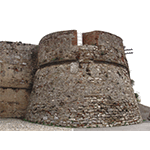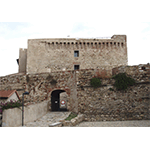Fortezza Medicea - Museo del Castello e della Cittą di Piombino [Medicean Fortress - Museum of the Castle and City of Piombino]
The Fortezza Medicea of Piombino was built from 1552 to 1557 at the order of Cosimo I de' Medici to the project of Giovanni Camerini. It is a star-shaped structure with elongated floor plan and bastions at the corners, typical of fifteenth-century fortifications and found also at Portoferraio. Encapsulated in this fortification was the castle, a building with central plan constructed in the second half of the 15th century. During his visit in 1504, Leonardo da Vinci studied its structure, hypothesising for it the construction of a circular tower (Madrid Ms. II - Manuscript "8936", conserved at the National Library of Madrid).
The fortress complex was used for sighting and as a bulwark of defence for the Tyrrhenian coastline, involved in maritime trade and in transporting iron from the Island of Elba. It ceased to serve these purposes when, in the mid-nineteenth century, the Castle was converted into a prison. This change led to substantial remodeling and rebuilding. Remaining a prison until the middle of the 20th century, the Fortress, after major restoration, can now be admired in relation to the most significant stages of its history.
Today the defensive complex houses the Museo del Castello e della Cittą and is destined to serve as site of exhibitions and temporary shows. A collection of ceramic and metal materials accompanied by explanatory panels and information posts will illustrate to visitors the fundamental stages in the life of the castle and the surrounding territory.
****************************
Texts by Graziano Magrini
English translation by Catherine Frost
Last update 30/gen/2008





